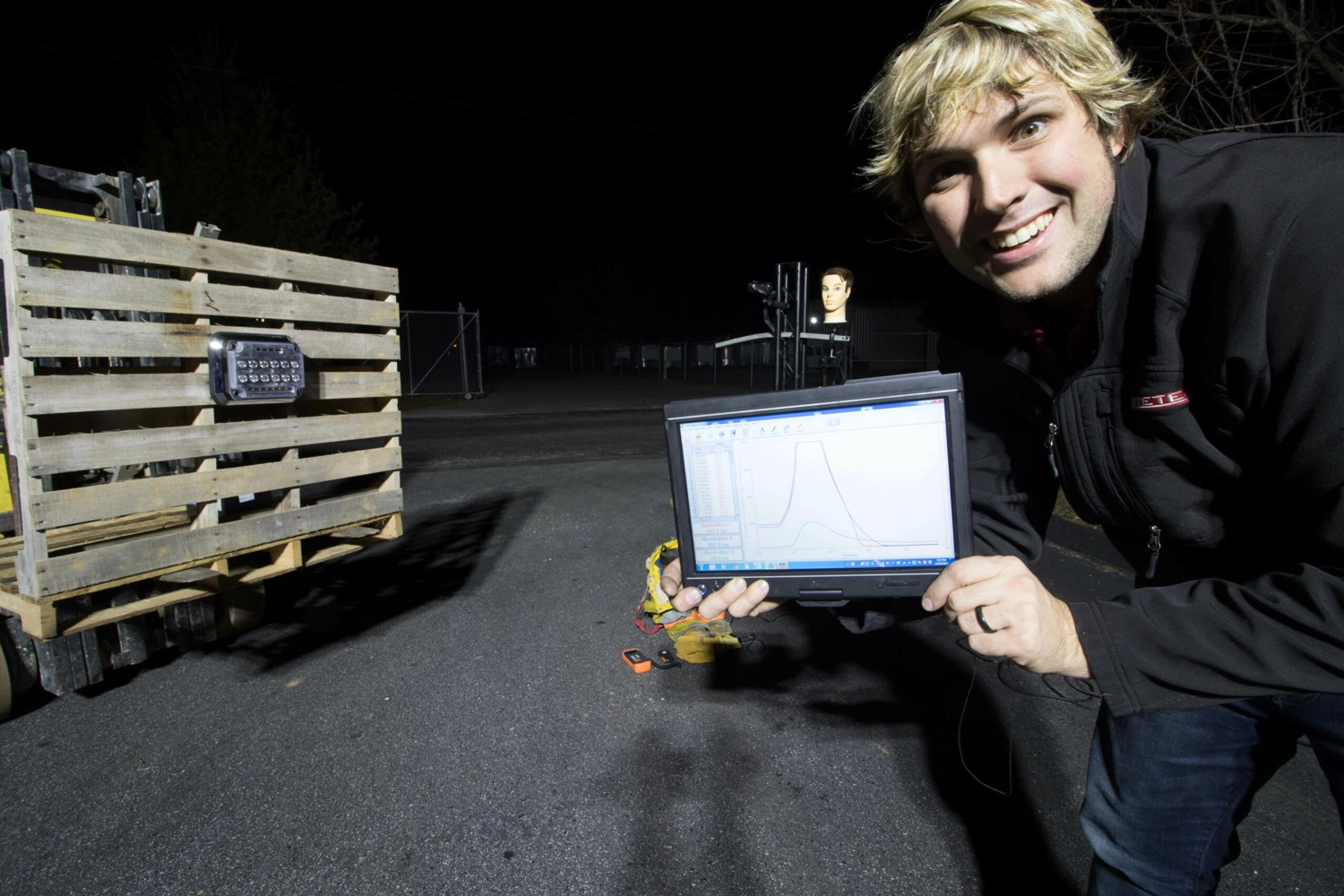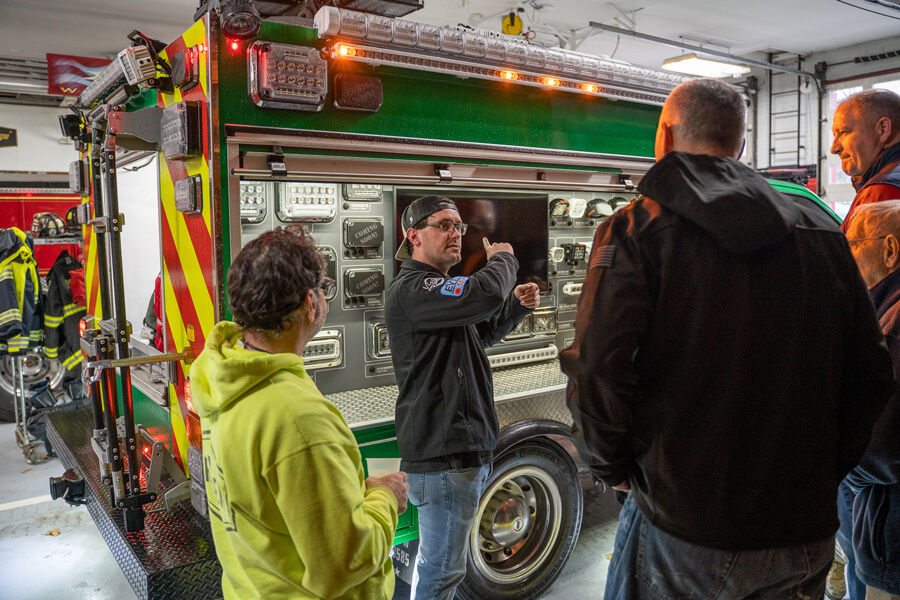Hi! It’s Sam from HiViz LEDs.
Today, I’m going to introduce you to my friend Jack and we’re going to do some modifications to Jack’s head that will help us understand how light hits fireman’s eyes and how we can reduce glare on the fire scene.
Glare and Light Reduction for Safe Emergency Scene Lighting
One of the most common things that we get asked at trade shows around the industry is, “How do we reduce the amount of light that hits us in the eyes?”
Human Anatomy Lesson on How Light Impacts Vision
Well, one of the things that is really cool is if you look at Jack’s face here, you will see how his eyebrows up top and then his eyeball is sucked back into the socket just behind that area, so the anatomic shape of the human face allows the top of your eyebrow, your hair, and the fireman’s helmet to act almost like a sun visor and keep light at your eyes.
Now the problem is when lights are mounted low on a fire truck, they shine right into the face and that glare is something that a lot of times causes us problems on the fire ground.
The Solution to Glare
So how do you address that?
You can either mount lights higher on the fire truck on the body, you can mount them on poles or you can put them on light towers.
For every light on the fire truck, if we’re talking as a general package, then reduce glare by using elevation to your vantage as it is the best way to do it.
The Glare Test
Now what we’re going to do is remove Jack’s eyes and replace them with photometric light sensors, which is really cool. This little device can sense how much light hits this target.
The Hypothesis
My hypothesis is that as light goes up in the air, we’re going to see a reduction light hitting his eyes with more light or the same amount of light hitting the area where we’re working, which in fact reduces glare.
Anyway let’s see if we can quantify this, we’ll catch you outside.
Setting up the Glare Test
See you later eyeballs! Here we go? One eye down, one eye to go.
Looking pretty damn good as you ask me. All right, we’re finished, here we go for the test!
Now, Jack’s got two eyes, each one has its own independent light sensor. What this let’s us do is figure out how much light is actually hitting his eyes versus hitting him from the top of the head and being shivered by the shape of his skull.
The Testing the Hypothesis
All right, so we made it outside.
The way we have the things set up, is I’ve got pallet on a forklift with Guardian mounted in the front of it. That’s going to shine down and out all over the fire scene. This simulates the light, whether it’s on a body or up in the air.
On the ground, we have a sensor mounted on this turnout gear. This turnout gear simulates anything that is fire ground equipment. It could be chain saws or whatever.
The next thing we’ve got is Jack with light sensors in his eyes. What’s going to happen is this forklift is going to go up and we’ll calculate how much light hits the work surface and then we’ll calculate how much light hits the guy in the eyes and we’ll be able to identify what’s occurring on the fire ground to see if elevation really does make a difference in reducing glare, so let’s get this thing started.
The Results of the Glare Test
Now you can see a graph along the red and blue line, that’s the left and right eye. The green line, now with more light on target than the fireman’s eyes effectively shows reduced glare.
This is pretty cool how this all works. But what you’ll see is elevating a fixture definitely reduces the amount of light hitting a fireman in the eyes.
Testing Glare While Wearing a Hard Hat
In the next step, we’re going to throw a hard hat on Jack and see what happens.
The Results of the Hard Hat Test
Check this out. This is really cool. What you see here is where the shadow is now cast. His eyes are completely in a shadow, based in this little short brim of a hat. Now imagine it’s a fire helmet, it’s the same sort of deal. When you’re able to elevate the light fixture, use that hat brim to your vantage and you’ll keep light out of the fireman’s eye.
So what you’ll see here is a sharper cut off. Right there is where the light fixture changed.
Oops! I just walked over top of the sensor.
But you’ll see right here. This is the difference in light elevation.
We’re able to get such a sharp cut off using the brim of a hat, you’ll see here we’ve got almost no light getting the fireman in the eyes at all, meanwhile we’ve got an elevated amount of the light on the target.
That’s our goal.
Testing with the Baseball Cap
All right, the next step is we’re going to use a baseball cap and see if we can shorten this up anymore.
What I want to see is if we can make this steeper cutoff using that brim and making the time elevation shorter. So, the lower light fixture is the faster we get the cut off and that’s what I’m hoping for.
The Results of the Baseball Cap Test
Check this out! We’ve got almost no light hitting the fireman’s eye.
This is a very quick cut off and you’ll see it right about where the natural elevation the forklift. In almost no time we’ve gone from glare in the fireman’s eye to no glare at all in the fireman’s eye with more light on the target than the guy’s head.
What Do our Light Glare Tests Show?
What is this all tell us? Well, when you look at the fire truck scene lighting package, it’s more than just taking a scene light and bolting it to the side of the body.
What you really want to do is look at the total, comprehensive ecosystem and figure out:
- do you have enough elevation
- do you have enough body lights
- do you have enough 12 volts
- do you have enough 110 amps
The best way to do that is to use some other principles we’ve learned here using our lighting equipment in the lab and to work with experienced lighting consultants like ones at HiViz LEDs. Our team members will help to come up with a package that effectively illuminates your fire scene, reduces glare on the fireman’s eyes and helps you do your job safer at night.
Speak to an Experienced LED Scene Lighting Consultant
For more information, check us out online at hivizleds.com or go to our Facebook page, it’s facebook.com/scenelighting. See you later.
We can be reached by online contact form or call 703-662-3458.


